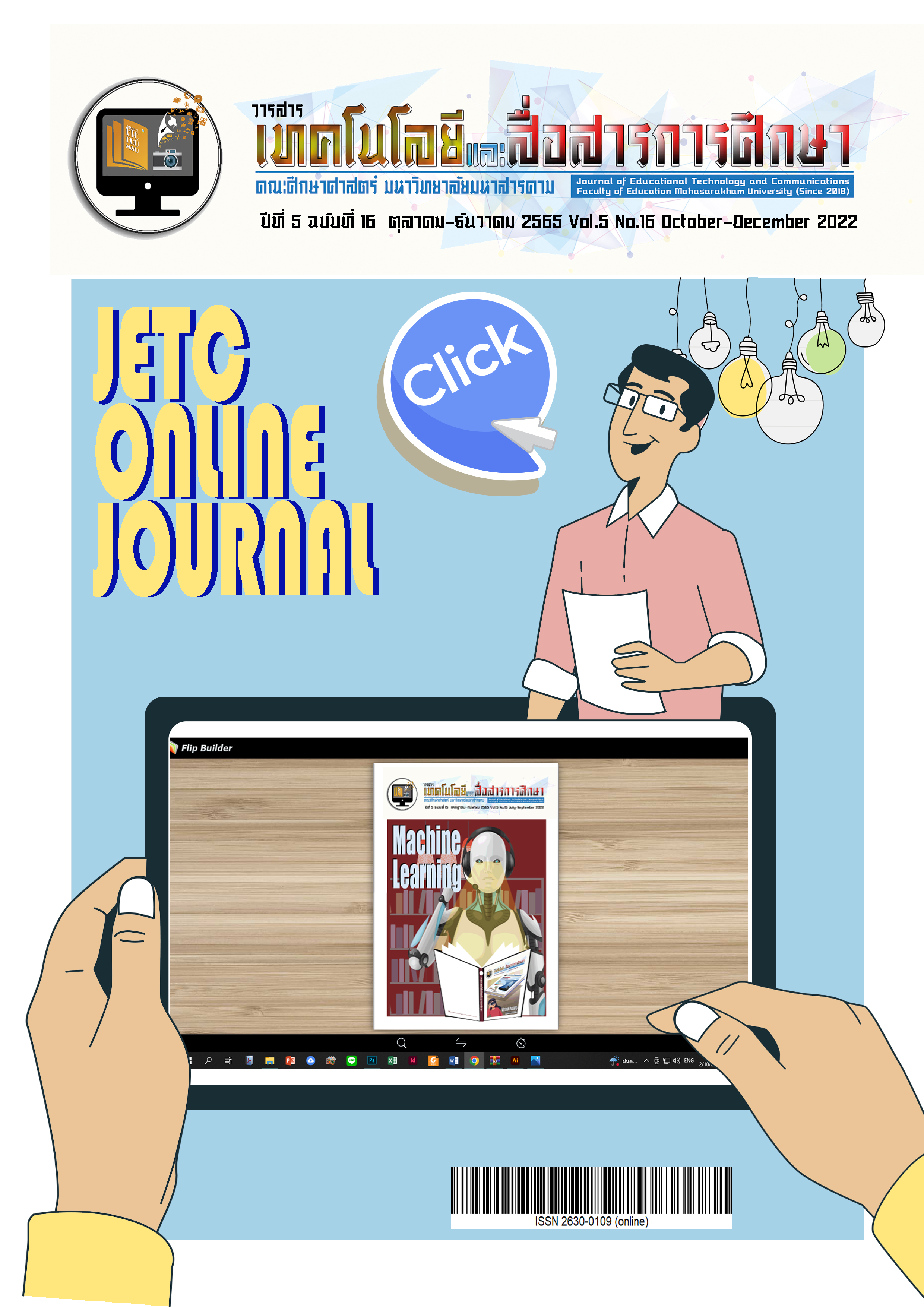The Development of Blended Learning Activity with Discovery Method to Enhance Computational Thinking of Mathayomsuksa 1 Students
Main Article Content
Abstract
The objectives of this research were 1) to develop blended learning activity with discovery method for Mathayomsuksa 1 students in basic computer coding and programming with an efficiency of 80/80, 2) to compare the computational thinking of students studied with the blended learning activity with discovery method, 3) to study the students’ satisfaction towards the blended learning activity with discovery method. The sample group consisted of twenty Mathayomsuksa 1 students in one class at an opportunity extended school, Sahatsakhan District, Kalasin Primary Educational Service Area Office 1, who were studying Computational Science in semester 1, academic year 2020. The sample was selected using the Cluster Random Sampling method. The research tools were 1) lesson plans of basic computer coding and programming, 2) computational thinking test, and 3) students’ satisfaction test. The data analysis applied average, standard deviation and t-test dependent.
The results were as follows;
1) The developed blended learning activity with discovery method for Mathayomsuksa 1 students in basic computer coding and programming had the efficiency (E1/E2) of 82.10/82.75 which met the set criteria of 80/80
2) Students who studied with the blended learning activity with discovery method in basic computer coding and programming developed by the researcher had higher computational thinking after studying significantly at .05 level 3) Students who studied with the blended learning activity with discovery method had a high level of agreement on overall satisfaction with a mean score of 4.52.
Downloads
Article Details
References
ชิตพล ชื่นตา. (2561, 8 มีนาคม). การจัดการเรียนรู้แบบค้นพบ (Discovery Method). http://chittaponchuenta.blogspot. com/2018/03/discovery-method.html
.
โชติกา สงคราม. (2562). การวิจัยเชิงปฏิบัติการเพื่อพัฒนาการจัดการเรียนรู้แบบใช้ปัญหาเป็นฐานที่ส่งเสริมทักษะการคิดเชิงคำนวณ เรื่อง ความน่าจะเป็น ของนักเรียนชั้นมัธยมศึกษาปีที่ 4. [วิทยานิพนธ์ปริญญามหาบัณฑิต, มหาวิทยาลัยนเรศวร] https://bit.ly/3S3fPUI
นพวรรณ ทะวะลัย. (2561). การพัฒนาบทเรียนบนเว็บตามหลักการสภาพแวดล้อมทางการเรียนรู้แบบเปิด (OLEs) ที่ส่งเสริมการคิดสร้างสรรค์ สำหรับนักเรียนชั้นมัธยมศึกษาปีที่ 3. [วิทยานิพนธ์ปริญญามหาบัณฑิต, มหาวิทยาลัยมหาสาคาม https://bit.ly/3VDfYRR
บัญญพนต์ พูลสวัสดิ์. (2559). เกมบนโปรแกรมเชิงจินตภาพ และแนวคิดเชิงคำนวณอย่างเป็นระบบ Visual programming and computational thinking game. information science and technology, 6(2), 9-16.
วรางรัตน์ เสนาสิงห์. (2562, 26 เมษายน). การสอนวิทย์แบบสร้างสรรค์ในศตวรรษที่ 21. คลังความรู้ SciMath. https://www.scimath.org/article-science/item/9607-21-9607.
วีระพงษ์ จันทรเสนา. (2563). การประเมินองค์ประกอบการเรียนแบบผสมผสานโดยใช้โปรแกรมเชิงจินตภาพที่ส่งเสริมทักษะการคิดเชิงคำนวน สำหรับนักเรียนใช้ประถมศึกษาปีที่ 4. [วิทยานิพนธ์ปริญญามหาบัณฑิต, มหาวิทยาลัยมหาสาคาม]. https://bit.ly/3D7jKvA
ศรายุทธ ดวงจันทร์. (2561). ผลการใช้แนวสะเต็มศึกษาในวิชาฟิสิกส์ที่มีต่อความสามารถในการคิดเชิงคำนวณของนักเรียนมัธยมศึกษาตอนปลาย. [วิทยานิพนธ์ปริญญาดุษฎีบัณฑิต, จุฬาลงกรณ์มหาวิทยาลัย]. https://bit.ly/3D56tmY
สรพงค์ สุขเกษม. (2560). การพัฒนารูปแบบการเรียนการสอนแบบผสมผสานรายวิชา คอมพิวเตอร์สารสนเทศขั้นพื้นฐาน สำหรับนิสิตระดับปริญญาตรี. [วิทยานิพนธ์ปริญญาดุษฎีบัณฑิต, มหาวิทยาลัยนเรศวร]. https://bit.ly/3TbPCob
Gonzalez, M. R., Gonzalez, J. P., &Fernandez, C. J. (2017). Which cognitive abilities underlie computational thinking? criterion validity of the computational thinking test. Computers in Human Behavior, 72, https://doi.org/10.1016/j.chb.2016.08.047
Palts, T., &Pedaste, M. (2020). Model of learning computational thinking. Informatics in Education, 19(1), https://doi.org/10.15388/infedu.2020.06
Yadav, A., Zhou, N., Mayfield, C., Hambrusch, S., &Korb, J. T. (2011). Introducing computational thinking in education courses. In Proceedings of the 42nd ACM technical symposium on Computer science education, (465-470), https://doi.org/10.1145/1953163.1953297

